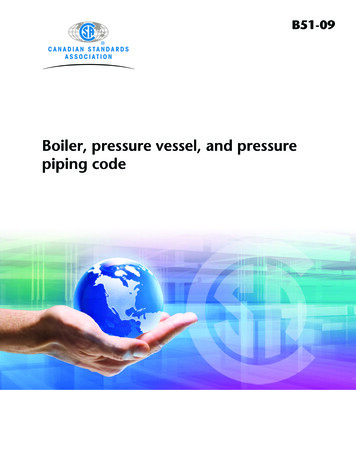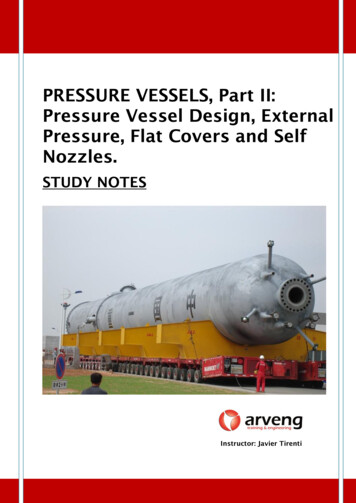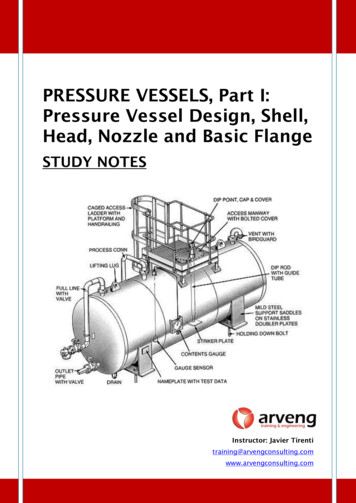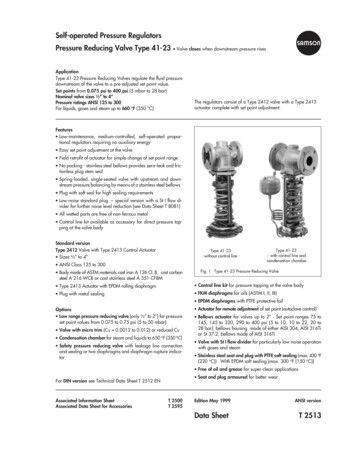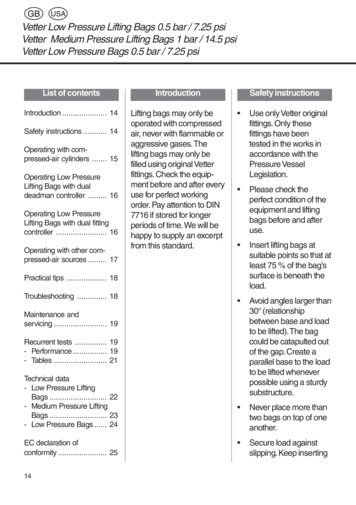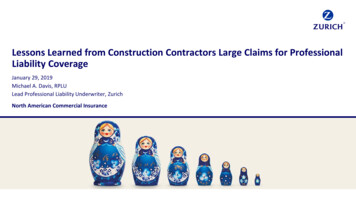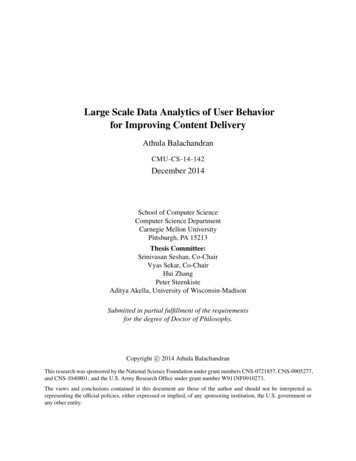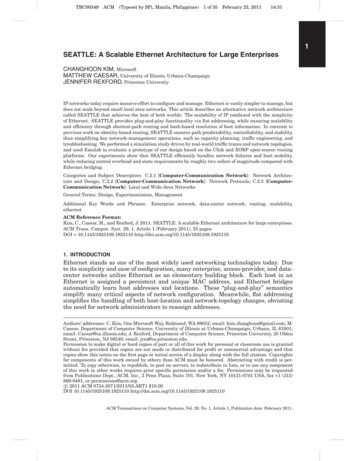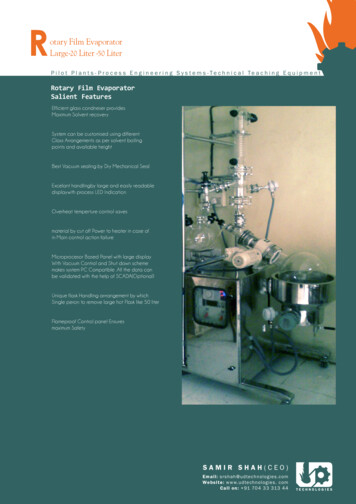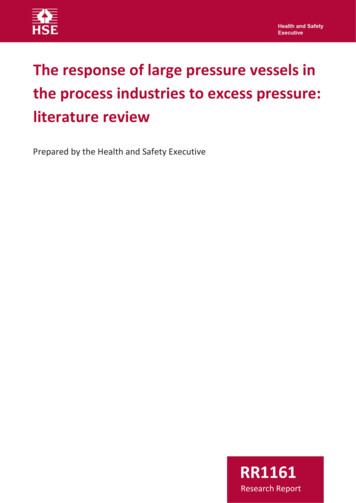
Transcription
The response of large pressure vessels inthe process industries to excess pressure:literature reviewPrepared by the Health and Safety ExecutiveRR1161Research Report
Crown copyright 2020Prepared 2018First published 2020You may reuse this information (not including logos) free of charge inany format or medium, under the terms of the Open GovernmentLicence. To view the licence nt-licence/, writeto the Information Policy Team, The National Archives, Kew, LondonTW9 4DU, or email psi@nationalarchives.gsi.gov.uk.Some images and illustrations may not be owned by the Crown socannot be reproduced without permission of the copyright owner.Enquiries should be sent to copyright@hse.gov.uk.Large pressure vessels are used in a wide range of chemicalprocess industries. They contain significant amounts ofenergy. In the event of a vessel failure, this energy could bereleased. This gives significant potential for harm to peopleand other plant. As part of effective risk control, pressurevessels are usually designed in accordance with establishedcodes that define their minimum strength.HSE is aware that there may be pressure vessel systems inGreat Britain where there is potential for exposure topressures greater than those allowed under relevantcurrent design codes. This can result from: errors duringthe original vessel design phase; a change in the designcode due to improved understanding of the reactionchemistry; or poor change management of plant or process.These situations may lead to insufficient capacity inpressure relief systems for vessels and the potential togenerate excess pressure leading to vessel failure.This report describes a literature review on the impact ofoverpressure on the likelihood of vessel failure. It includesan assessment of impact of different design standards. Itcaptures sources of relevant good practice andsupplementary information that may help in theassessment of risk. The report covers: Likelihood of overpressures and failures; Comparison of different construction standards; Predictions of the effects of overpressures; Calculations of burst pressures.This report and the work it describes were funded by the Health andSafety Executive (HSE). Its contents, including any opinions and/orconclusions expressed, are those of the authors alone and do notnecessarily reflect HSE policy.2
Theresponseof largepressurevessels inLoremipsumdolorsit ametconsectetueradipiscingtheprocess industriesto excess elitpressure:literature reviewJames Hobbs, Philip Lees and John HareHealth and Safety ExecutiveHarpur HillBuxtonDerbyshire SK17 9JN3
KEY MESSAGESPressure vessels are used in a wide range of process industries and can hold liquids and gases at highpressures. Therefore, they can contain significant amounts of energy that could be released in theevent of a vessel failure, with significant potential for harm to people and other plant.The Chemicals, Explosives and Microbiological Hazards Division (CEMHD) of the UK Health and SafetyExecutive (HSE) are aware that there may be systems where there is a potential for pressure vesselsto be exposed to pressures greater than those allowable under the relevant design code. This reportcaptures sources of relevant good practice and supplementary information that may help in theassessment of risk.A literature review was undertaken, and design and assessment standards evaluated, to identifyrelevant published work that considers the likelihood of failure of pressure vessels due tooverpressure events to determine, if possible, what level of overpressure may cause damage orfailure of pressure vessels. This identified the following: There is considerable variability in pressure vessel failure rates calculated in literature. Thismay either be due to the quality of data collection, or an indication that failure rates mayvary depending on factors such as the fluid service and the broader operating environment.For intact vessels, burst pressure can be estimated as the pressure at which the hoop stressreaches the ultimate tensile strength of the material. There are many formulae available forthe calculation of burst pressure, but using the simple Barlow formula is likely to give asufficiently accurate estimate.A number of other factors are likely to affect the burst pressure, including:o additional thickness due to corrosion allowance;o material properties exceeding the minimum specified for the grade; ando the duration of the overpressure.The ratio of the burst pressure to the maximum allowable pressure for the vessel willdepend to the largest degree on the maximum allowable stress defined by the design code.The allowable stress could vary by a factor of two. Therefore, any system predicting theeffects of overpressure, or setting limits for allowable overpressure, must take into accountthe code to which the vessel was designed.The lowest ratio for burst pressure to MAWP should be 2.35, for an intact vessel, or 2.0 for acracked vessel, assuming the cracks have been assessed and the vessel re-rated if necessary.The estimating level of overpressure at which damage may occur is more difficult, but itshould not be below the hydrotest pressure (at least 30 % higher than MAWP).These conclusions have been based on set safety factors for design stresses and calculationspredicting actual burst pressure for intact and corroded cylindrical vessels. The assumptionhas been made that the findings will be applicable to other simple geometries where theinternal pressure is the main source of stress, such as for heads and spherical vessels.The complex nature of nozzle and flange designs means that this approach has not beenpossible for these components. However, from the lack of information on thesecomponents it should not be assumed that they would not fail during an overpressure event.4
EXECUTIVE SUMMARYBackgroundPressure vessels are used in a wide range of process industries. Many are large and can hold liquidsand gases at high pressures, and therefore contain significant amounts of energy that could bereleased in the event of a vessel failure, with significant potential for harm to people and otherplant. To control the risk, vessels are designed and operated to strict codes that define both theminimum strength of the vessels and the relief systems, which aim to prevent overpressuresituations occurring.The Chemicals, Explosives and Microbiological Hazards Division (CEMHD) of the UK Health and SafetyExecutive (HSE) are aware that there may be systems where there is a potential for pressure vesselsto be exposed to pressures greater than those allowable under the relevant design code. Thesesituations can come about as a result of specific overpressure scenarios having been either missed ordiscounted during the original design, an improved understanding of the reaction chemistry, or poorchange management of plant or process, all leading to insufficient capacity in relief systems and thepotential to generate excess pressure. Therefore, a literature review was conducted; to identify anyrelevant previously published work on the impact of overpressure on the likelihood of vessel failure.This report captures sources of relevant good practice and supplementary information that may helpin the assessment of risk.Aims Identify relevant published work that deals with the impact of various levels of overpressureon the likelihood of failure of pressure vessels.Determine, if possible, what level of overpressure may cause damage or failure of pressurevessels.Methods (see Methods section) A literature review was conducted, with the initial search terms being overpressure, burst,fracture, flange leakage, leakage, pressure vessel, probability of failure, likelihood of failure,frequency of failure, relief discharge capacity and failure mode. Further literature was identified from sources known to the report authors, and citations inpapers obtained in the literature search. The relevant literature that was identified, together with design standards for pressurevessels and fitness-for-service procedures were assessed for information in the followingareas:oLikelihood of overpressures and failures,oComparison of different construction standards,oPredictions of the effects of overpressures, andoCalculations of burst pressures.5
Main findings1. There is considerable variability in pressure vessel failure rates calculated in literature. Thismay either be due to the quality of data collection, or an indication that failure rates mayvary depending on factors such as the fluid service and the broader operating environment.2. For intact vessels, burst pressure can be estimated as the pressure at which the hoop stressreaches the ultimate tensile strength of the material. There are many formulae available forthe calculation of burst pressure, but using the simple Barlow formula is likely to give asufficiently accurate estimate.3. A number of other factors are likely to affect the burst pressure, including:a. additional thickness due to corrosion allowance;b. material properties exceeding the minimum specified for the grade; andc. the duration of the overpressure.4. The ratio of the burst pressure to the maximum allowable pressure for the vessel willdepend to the largest degree on the maximum allowable stress defined by the design code.The allowable stress could vary by a factor of two. Therefore, any system predicting theeffects of overpressure, or setting limits for allowable overpressure, must take into accountthe code to which the vessel was designed.5. Both the American Society of Mechanical Engineers' ASME Boiler and Pressure Vessel Code,Section VIII and the Pressure Equipment Directive allow accumulation during pressure reliefabove the maximum allowable working pressure, but differ in the permissions they apply.6. The likely effect of various levels of overpressure on pressure vessels has been presented intables in a number of publications (Centre for Chemical Process Safety (CCPS), Williams andProphet), but they are merely examples and are mainly for ASME VIII carbon steel vessels.The publications also caution against using the tables where there is existing damage to thevessel.7. The American Petroleum Institute API 581 document assumes that vessels will certainly failat an overpressure factor of 400 % design pressure and lists potential consequences atvarious degrees of overpressure up to this point. However, it is not clear on whatexperimental evidence these assumptions are based.8. While API 581 assumes that vessels will certainly fail at an overpressure factor of 400 %design pressure, there is some incident evidence that vessels sometimes survive to higherdegrees of overpressure before failure.9. There is also corresponding evidence to suggest that vessels sometime fail at lower degreesof overpressure, possibly because these vessels are built to different design codes.10. In the special case of fire-caused boiling liquid expanding vapour explosion (BLEVE) failure,weakening of the wall due to overheating can be sufficient to cause vessel failure within thedesign pressure.11. Davenport and Warwick found that while leakage failures can occur on very thick walledvessels, there is some evidence to suggest that catastrophic failure becomes an increasinglylikely failure mode as the vessel wall thickness increases.12. The lowest ratio for burst pressure to maximum allowable working pressure should be 2.35,which would be for a vessel constructed to British design codes BS 5500, or PD 5500.6
13. A corroded vessel found to be acceptable to the API 579 Fitness-for-Service procedure, mayhave a remaining strength factor as low as 0.9, reducing the ratio of minimum burst pressureto maximum allowable working pressure (MAWP) to 2.1.14. Cracks may have an effect on the burst strength if they have propagated since hydrotesting,or at pressures above the hydrotest pressure. Brittle failure of vessels would be more likelyat cold temperatures, or under shock loading. Assessing a cracked vessel using a fitness forservice assessment should result in a ratio of burst pressure to MAWP of at least 2.15. The estimating level of overpressure at which damage may occur is more difficult, but itshould not be below the hydrotest pressure (at least 30 % higher than MAWP).16. The ratios of burst pressure to MAWP given assume that the condition of the vessel isknown, and has been rerated if necessary. Undetected corrosion or cracks couldsignificantly decrease the burst pressure.17. These conclusions have been based on set safety factors for design stresses and calculationspredicting actual burst pressure for intact and corroded cylindrical vessels. The assumptionhas been made that the findings will be applicable to other simple geometries where theinternal pressure is the main source of stress, such as for heads and spherical vessels.18. The complex nature of nozzle and flange designs means that this approach has not beenpossible for these components. For example, the bolting force for a flanged joint isdependent on a number of factors, such as flange diameter, gasket type and location andinternal pressure. Therefore it would not be possible to predict an overpressure ratio likelyto cause failure. However, from the lack of information on these components it should notbe assumed that they would not fail during an overpressure event.7
CONTENTSKEY MESSAGES . 4EXECUTIVE SUMMARY. 51INTRODUCTION . 92METHODS.103LIKELIHOOD OF OVERPRESSURES AND FAILURES.
the calculation of burst pressure, but using the simple Barlow formula is likely to give a sufficiently accurate estimate. 3. A number of other factors are likely to affect the burst pressure, including: a. additional thickness due to corrosion allowance; b. material properties exceeding the minimum specified for the grade; and c. the duration of the overpressure. 4. The ratio of the burst .
